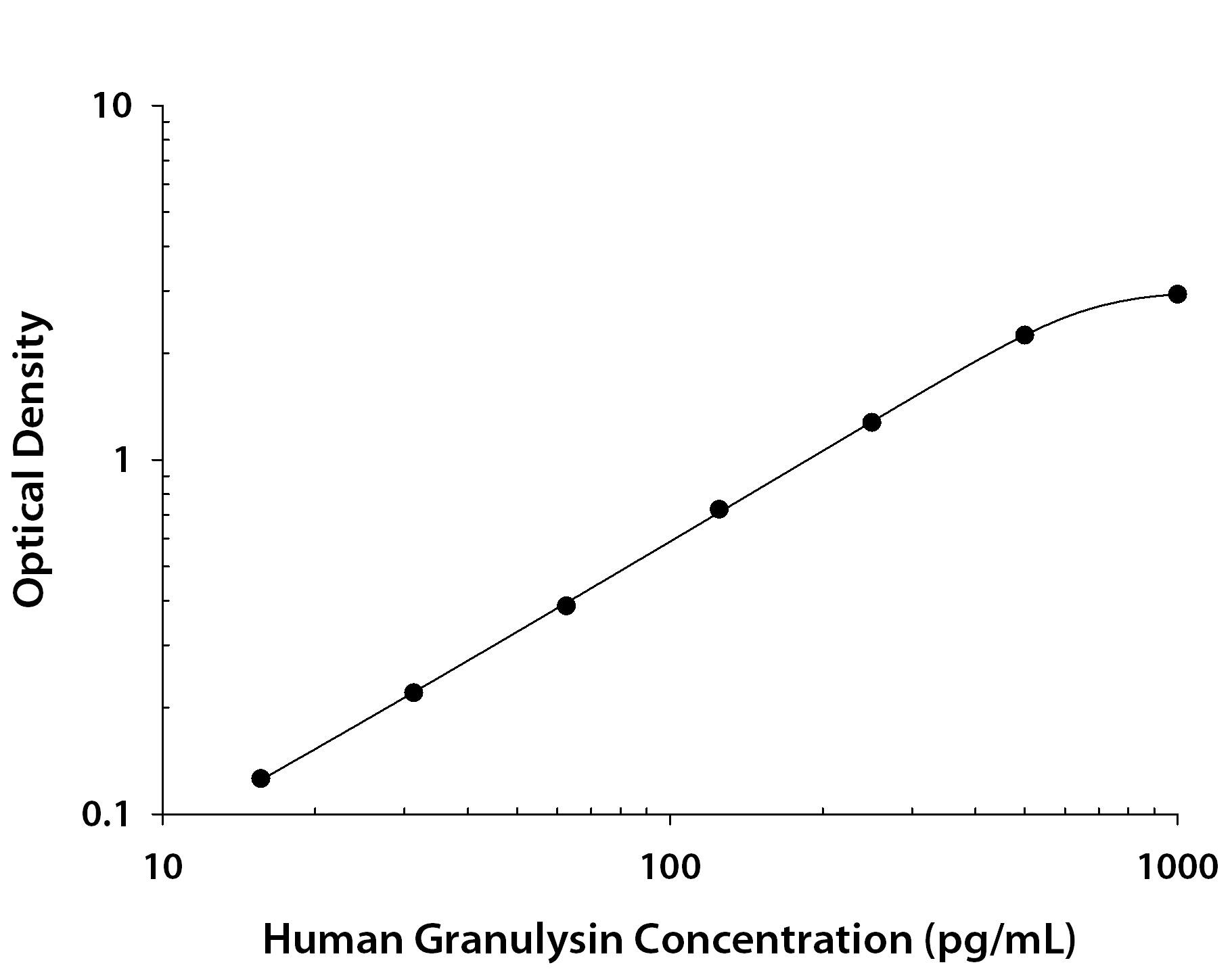Human Granulysin Antibody
R&D Systems, part of Bio-Techne | Catalog # MAB3138

Key Product Details
Species Reactivity
Applications
Label
Antibody Source
Product Specifications
Immunogen
Arg23-Leu145
Accession # P22749
Specificity
Clonality
Host
Isotype
Scientific Data Images for Human Granulysin Antibody
Human Granulysin ELISA Standard Curve.
Recombinant Human Granulysin protein was serially diluted 2-fold and captured by Mouse Anti-Human Granulysin Monoclonal Antibody (Catalog # MAB3138) coated on a Clear Polystyrene Microplate (DY990). Mouse Anti-Human Granulysin Monoclonal Antibody (MAB31381) was biotinylated and incubated with the protein captured on the plate. Detection of the standard curve was achieved by incubating Streptavidin-HRP (DY998) followed by Substrate Solution (DY999) and stopping the enzymatic reaction with Stop Solution (DY994).Applications for Human Granulysin Antibody
ELISA
This antibody functions as an ELISA capture antibody when paired with Mouse Anti-Human Granulysin Monoclonal Antibody (Catalog # MAB31381).
This product is intended for assay development on various assay platforms requiring antibody pairs. We recommend the Human Granulysin DuoSet ELISA Kit (Catalog # DY3138) for convenient development of a sandwich ELISA.
Formulation, Preparation, and Storage
Purification
Reconstitution
Formulation
Shipping
Stability & Storage
- 12 months from date of receipt, -20 to -70 °C as supplied.
- 1 month, 2 to 8 °C under sterile conditions after reconstitution.
- 6 months, -20 to -70 °C under sterile conditions after reconstitution.
Background: Granulysin
Granulysin (formerly NKG5 or Lymphokine LAG-2) is a member of the saposin-like protein (SAPLIP) family of membrane disrupting proteins (1). Granulysin is expressed in granules of natural killer and activated cytotoxic T cells. It exhibits cytolytic activity against intracellular or extracellular microbes and also tumors, either alone or in synergy with perforin (2). Human granulysin has structural similarity and 30 - 40% aa identity to granulysins and NK-lysins of other mammals such as bovine, porcine and canine; similar peptides in rodents have not been identified (1). The 15 kDa unglycosylated protein contains five helical domains; helix 2 and 3 contain 9 arginines and one cysteine critical for activity. Peptides of either helix 2 or 3 will lyse bacteria, while helix 3 is needed to lyse tumor targets (3, 4). One isoform designated 519 uses a different start codon, has no signal peptide sequence and is poorly expressed (5). A post-translationally processed 9 kDa form is present in acidified granules and is less lytic than the 15 kDa form at granule pH (6). IL-15 is necessary and sufficient for granulysin upregulation in CD8 T cells (2). Nanomolar granulysin promotes chemotaxis and increases production of chemokines by monocytic cells, while micromolar local concentrations are needed for lysis (7). Experimental evidence supports the following mechanism for activity against intracellular pathogens (8). First, granulysin forms clusters in lipid rafts due to interaction of positive charges in helices 2-3 with acidic sphingolipids. After endocytosis, early endosomes fuse with phagosomes, probably regulated by small GTPase rab5. Granulysin binds microbial membranes through charge interactions and disrupts them, probably via scissoring actions of granulysin molecules (9, 10).
References
- Clayberger, C. and A.M. Krensky (2003) Curr. Opin. Immunol. 15:560.
- Ma, L.L. et al. (2002) J. Immunol. 169:5787.
- Wang, Z. et al. (2000) J. Immunol. 165:1486.
- Linde, C.M.A. et al. (2005) Infect. Immun. 73:6332.
- Yabe, T. et al. (1990) J. Exp. Med. 172:1159.
- Hanson, D.A. et al. (1999) Mol. Immunol. 36:413.
- Deng, A. et al. (2005) J. Immunol. 174:5243.
- Walch, M. et al. (2005) J. Immunol. 174:4220.
- Ernst, W.A. et al. (2000) J. Immunol. 165:7102.
- Anderson, D.H. et al. (2003) J. Mol. Biol. 325:355.
Alternate Names
Entrez Gene IDs
Gene Symbol
UniProt
Additional Granulysin Products
Product Documents for Human Granulysin Antibody
Product Specific Notices for Human Granulysin Antibody
For research use only
